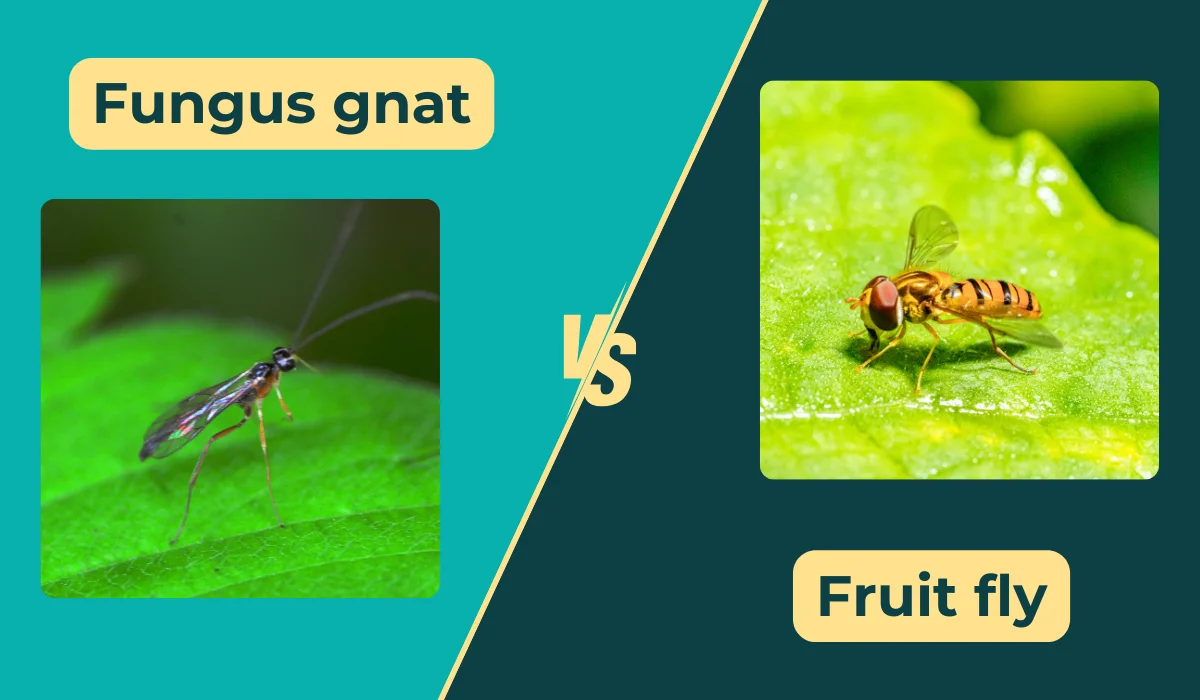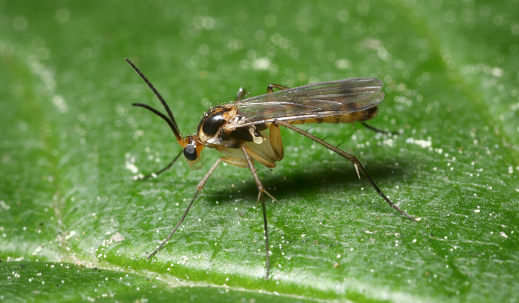Fungus gnats or fruit flies? How to tell the difference in Florida
If you see tiny flies around your kitchen or houseplants, you may wonder if they’re fungus gnats or fruit flies. Florida’s warm, humid climate helps both thrive, but they breed in different places and need different fixes. Identifying the pest is the first step to stopping an infestation.
In Florida homes, fruit flies gather around overripe fruit, sink drains, and trash cans, while fungus gnats appear near potted plants and moist soil. Both are tiny flies, but their habits and looks make them easy to tell apart.
In this guide, we’ll teach you how to tell the difference between fungus gnats and fruit flies in Florida, what attracts them, and how to prevent them from taking over your home.
Key takeaways
- Fruit flies thrive around food sources like overripe fruit, sink drains, and garbage, while fungus gnats prefer moist soil and houseplants.
- Fruit flies are light brown with red eyes, while fungus gnats resemble tiny black flies with long legs and slender antennae.
- Overwatering and moist soil often cause fungus gnats, while uncovered fruit and food waste encourage fruit fly infestations.
- DIY traps may help, but persistent infestations often require professional pest control for lasting results.
Spotting the difference: Fungus gnats vs fruit flies in Florida

Fungus gnats and fruit flies may look alike at first, but their appearance gives clear clues. Fruit flies are tan to light brown with distinct red eyes, while fungus gnats are darker and resemble tiny black flies. Their long legs and thin antennae make fungus gnats look more like tiny mosquitoes than house flies.
Tiny flies near sink drains or garbage disposals are usually fruit flies. If they hover around overwatered plants or potting soil, they’re likely fungus gnats. Both pests reproduce quickly, which means one or two can turn into large numbers in just days.
Many Florida homeowners deal with both pests at the same time, especially in summer when humidity and standing water create ideal breeding grounds.
Where do fruit flies come from in Florida homes?
Fruit flies are drawn to food. Overripe fruit, sticky trash cans, and damp sink drains are common breeding grounds. These flies lay eggs in fermenting organic material, and their larvae feed until they develop into a pupa stage and emerge as adults.
In Florida, where fresh fruit is common year-round, fruit flies quickly find their way indoors. Leaving bananas, tomatoes, or citrus uncovered can trigger an infestation. They’re especially common in South Florida homes with open kitchens and outdoor spaces.
If you want to get rid of fruit flies, removing food sources is key. Simple DIY methods, like apple cider vinegar mixed with dish soap, can trap adult flies, but if you don’t eliminate their breeding sites, they’ll return.
Why fungus gnats are a problem for Florida houseplants
Unlike fruit flies, fungus gnats thrive in houseplants and potting soil. They breed in moist soil, where larvae feed on decaying matter. In large numbers, larvae may also damage plant roots, leading to drooping leaves or slow plant growth.
Overwatering houseplants often causes fungus gnats indoors. Florida’s humid climate makes damp soil the perfect breeding ground for these pests. Outdoor potted plants, especially those kept on shaded patios, are also at risk.
To stop fungus gnats, let the soil dry between waterings and empty standing water from saucers. Sticky traps catch adults, but controlling larvae in soil is the real solution.
Life cycle differences: From eggs to adults
The life cycle of fruit flies is closely tied to fermenting food, while fungus gnats depend on moist soil. Both pests reproduce quickly, but their eggs hatch in different environments.
Fruit flies lay eggs in decaying fruit, trash, or sink drains. Their larvae, sometimes mistaken for maggots, feed for several days before reaching the pupa stage. Within a week, adults emerge and start laying eggs again.
Fungus gnat larvae develop in potting soil, feeding on decaying organic material. In some cases, they chew on plant roots, which can stress young or overwatered plants. Bacillus thuringiensis (BT) products designed for soil treatment can target fungus gnat larvae without harming plants or pets.
Since both pests multiply quickly, knowing their life cycle helps you stop them before a full infestation develops.
DIY methods and professional pest control options
Many Florida homeowners start with DIY methods when they notice small flies indoors. Apple cider vinegar traps, sticky traps, and fruit fly traps are easy, inexpensive tools that can help reduce adult populations. For fungus gnats, drying out moist soil and using sand or gravel as a top layer can slow their breeding.
Some homeowners use essential oils around windows or doors, but these only give short-term relief. Indoor insecticides may seem like an easy fix, but if you don’t remove the source, the flies usually return.
When flies keep coming back, it may be time for professional pest control. Drain flies, midges, and other small flying insects often appear at the same time as fruit flies and fungus gnats, making it harder to identify the source on your own.
Pest management experts can locate hidden breeding grounds, from sink drains to plant soil, and recommend safe treatments.
Native Pest Management offers pet-friendly fruit fly and fungus gnat control across Florida. Whether the issue is fruit flies in your kitchen or fungus gnats in your plants, our treatments stop infestations from coming back.
Making the right choice for your Florida home
Choosing the right pest control partner can save you time, frustration, and keep your home healthy.
At Native Pest Management, we focus on long-term solutions that are safe for your family, pets, and plants. Our trained team can handle small fly infestations quickly before they grow into bigger problems.
Contact us today to schedule your free inspection and start your path to a pest-free home.
FAQs
How do I know if I have fruit flies or fungus gnats?
Fruit flies are light brown with red eyes and hover around food, trash, and sink drains. Fungus gnats are tiny black flies that often gather around moist soil and houseplants.
What causes fungus gnats indoors?
Fungus gnats are usually caused by overwatering potted plants. Their larvae develop in moist soil rich in organic matter, especially in overwatered plants or potting soil.
What is the fastest way to get rid of fruit flies?
To get rid of fruit flies, clean drains, seal trash, and throw out ripe fruit. Apple cider vinegar with dish soap traps can reduce adult flies while you remove the source.
